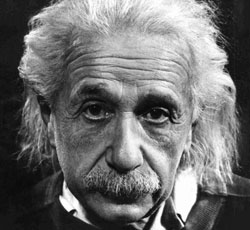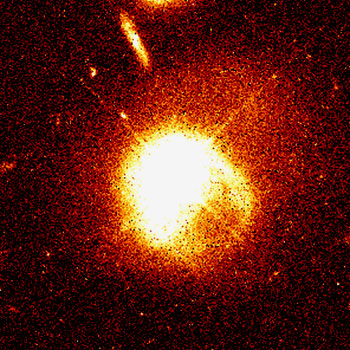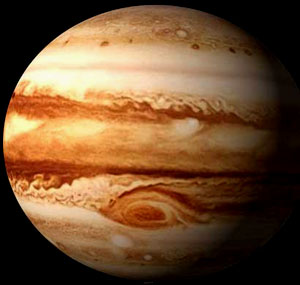"One of the predictions from
Einstein's theory of relativity which is his theory of
gravitation is that everything is effected by gravity. Of
course, we know that a lot of things are, including light.
So,
for example, if you have radiowaves from a distant quasar or a
distant star that passes by a massive object like the sun or
Jupiter on its way to our telescopes, then we astronomers would
see a slight change in the direction towards this quasar.
This
change would be caused by a slight bending of the radiowaves by
the solar gravitational field.

Albert Einstein (1879-1955).
German-born American
theoretical physicist who formulated the theories of special and
general
relativity that included the formula E=mc2 (energy equals mass
times the speed of light
squared) and said that nothing in our universe could go faster
than the speed of light,
186,000 miles per second.
Now, this is from Einstein's prediction of gravity and this was
first verified in 1919 and it has been verified with many radio
and optical observations over the last thirty years and his
prediction of the bending of this light is right on.
About two years ago I'm the experimentalist in this pair of
astronomers. Sergei Kopeikin, Ph.D., at the University of
Missouri-Columbia, is the theoretician.
After discussing things
related to Einstein's equation, he decided to ask the question
about Einstein's theory: How do some of his (Einstein's)
predictions change about gravity if the gravitational force from
any object travels outward at a finite speed before affecting
other objects or radiowaves?
Because most physicists don't think
gravitational force is instantaneous. They think it travels also
at the speed of light.
SO, WHAT YOU ARE TRYING TO DO IS TEST THE QUESTION: DOES GRAVITY
HAVE A SPEED, SO TO SPEAK, AS LIGHT TRAVELS 186,000 MILES PER
SECOND AND TAKES EIGHT MINUTES TO GET HERE FROM THE SUN TO THE
EARTH, FOR EXAMPLE.
That's right.
DO YOU MEAN THAT WHAT YOU ARE GOING TO TRY TO TEST THIS WEEKEND
AND SUBSEQUENTLY IS IF THE SUN WERE SUDDENLY REMOVED, WOULD IT
TAKE EIGHT MINUTES FOR THE EARTH TO KNOW THAT?
That's exactly right. We know it takes 8 minutes for the earth
to know there is no more light coming from the sun. But we also
want to test whether it also takes 8 minutes before the earth
stops orbiting and just travels away if the sun were magically
moved away.
In order to get the position discrimination or accuracy (as
Jupiter passes the quasar's light), we need, we are using 11
radio telescopes stretching from Germany to the Virgin Islands
all the way to Hawaii. So we have this colossal array that did
not exist in the 1970s. And you need something very big in order
to measure this very accurately this position of the quasar. So
this is the main new technology we have now we didn't have the
last time this passage occurred.
.
TOMORROW ON SUNDAY, SEPTEMBER 8, WILL THEN BE A COMBINATION OF
TWO THINGS: YOUR ADVANCED RADIO TELESCOPE EQUIPMENT AND THE
PASSING OF JUPITER PAST THIS QUASAR THAT IS GOING TO ALLOW YOU
TO SEE IF YOU CAN MEASURE FOR THE VERY FIRST TIME THE SPEED OF
GRAVITY?
That's right. Over about ten hours as Jupiter and the quasar are
observed with all of these telescopes. They are connected as one
big telescope. We will see the position of the quasar actually
move slightly in the sky in response to Jupiter's gravitational
field. We will compare it to Sergei Kopeikin's theory, which is
Einstein's theory, but with the added wrinkle that Jupiter is
moving and by comparing what we measure to what Einstein and Sergei's theory say we should get, we will then be able to
determine the speed of gravity.
WHAT IF IT TURNS OUT TO BE SLOWER OR FASTER THAN THE SPEED OF
LIGHT?
Well, that's a good question. If it turns out to be faster or
slower or infinite than the speed of light, this clearly would
be very surprising. Again, because in modern physics, especially
gravitational theory and electromagnetic theory, one of the
cornerstones is that the speed of light is this limiting
velocity that anything not only light that everything can
obtain.
If we show that that is not true for gravity, some of
the basic postulates of relativity theory and some of the other
theories and ideas about how the universe evolved when there
were very large gravitational fields would have to be modified.
So, gravity is an important force in the universe. No one yet
has made a serious measurement on how fast gravity travels from
the objects producing the gravity to influence other objects
further away.
With light, we have been measuring its speed for hundreds of
years. We know it to one part in a million and it's constant.
It's the limit as far as we know.
SO TOMORROW, NOT ONLY ARE YOU TESTING THE SPEED OF GRAVITY, BUT
YOU ARE TESTING ALBERT EINSTEIN'S THEORY OF GENERAL RELATIVITY?
Yes, we are. This is another. There have been many tests of
Einstein's theory. He has come through with flying colors. And
this is another test that we will make. It's quite a bit
different than some of the others, but it is another test of
Einstein's theory. That's correct.
HOW LONG WILL IT TAKE YOU TO KNOW WHAT THE RESULTS ARE?
These telescopes record the data at the sites they are. The data
or signals from the quasar are recorded on videotape similar to
what is used for television. Then those tapes are federal
expressed to a central processing station in Socorro, New Mexico
where we have what is called a correlator. What the correlator
does is take the signals received from each antenna and puts
them together. It in a sense focuses the signals and it makes a
focal point, a focus, from all of these different antennas and
makes up a fictitious very large antenna.
Basically, we get an
image of the quasar every minute of time and through the day we
can monitor the position of our quasar from the image we are
getting and see how it changes and compare it to the predictions
of Einstein and Kopeikin. Our goal is to have a preliminary
answer by mid-November.
Gravity is one of three fundamental forces and is the least
understood of all the forces in the universe. And it's possible
it might have some surprising properties. If the speed is in
fact faster than the speed of light it will be very surprising
and very interesting.
IT WOULD KIND OF TURN PHYSICS A LITTLE UPSIDE DOWN, WOULDN'T IT?
I believe it would, yes. Yes, it would."




